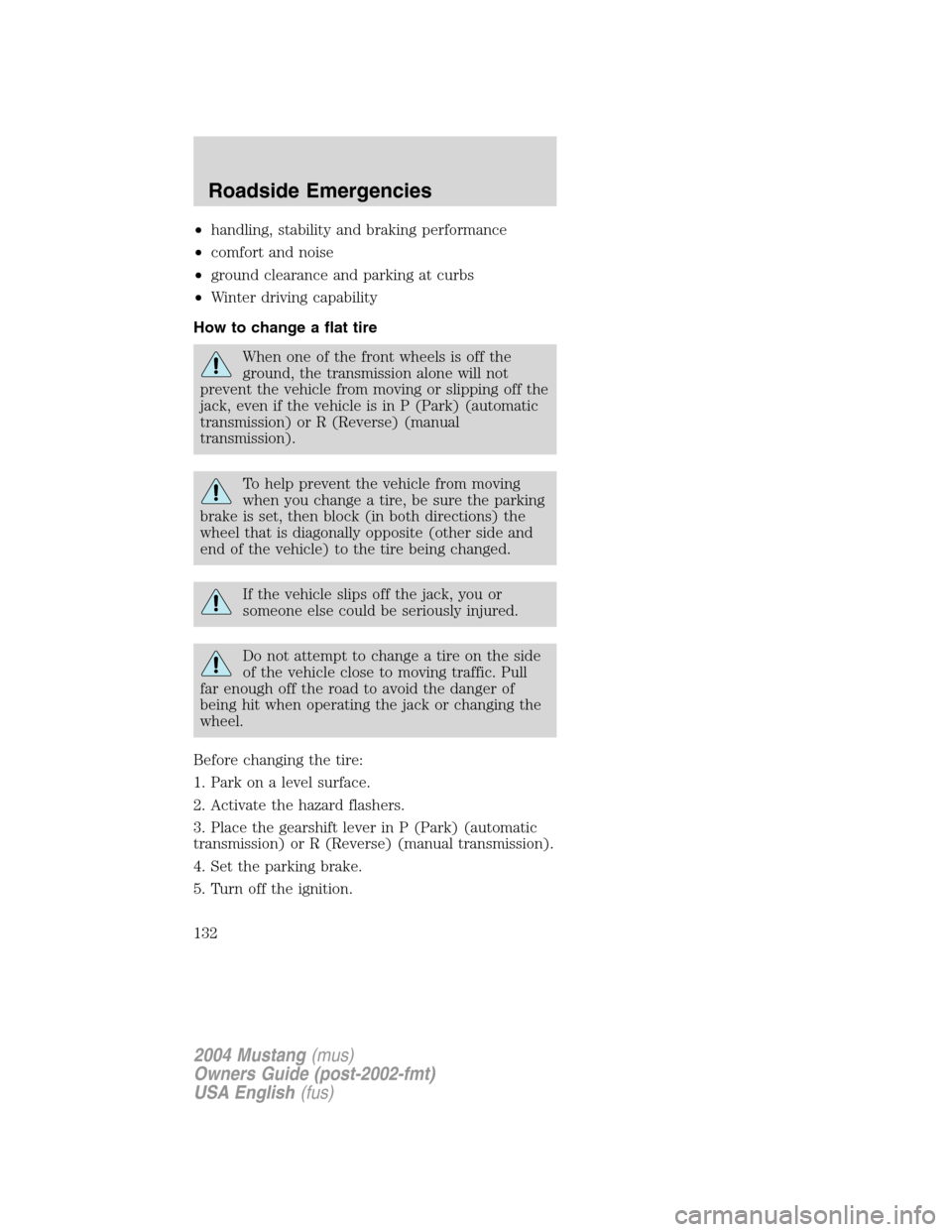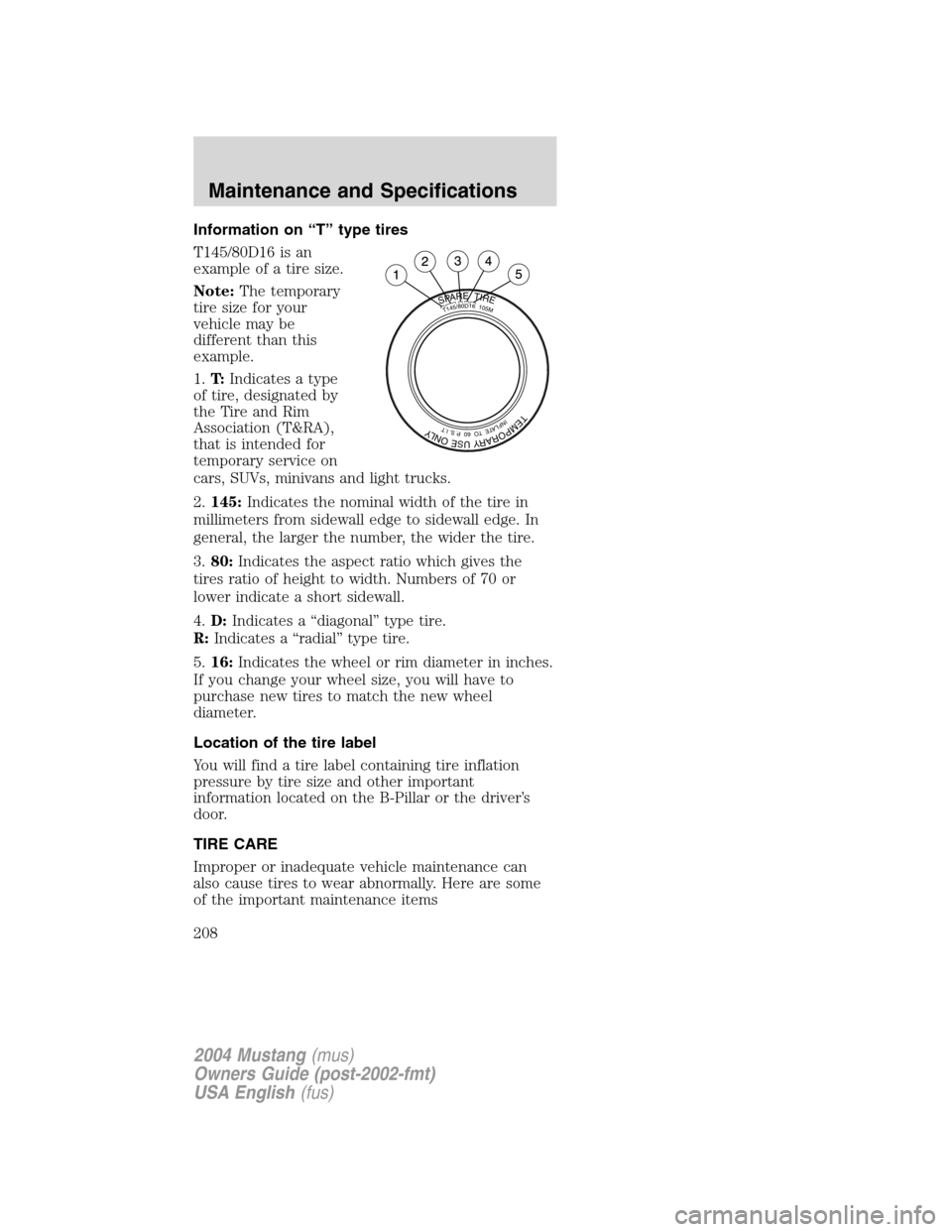Page 132 of 240

•handling, stability and braking performance
• comfort and noise
• ground clearance and parking at curbs
• Winter driving capability
How to change a flat tire
When one of the front wheels is off the
ground, the transmission alone will not
prevent the vehicle from moving or slipping off the
jack, even if the vehicle is in P (Park) (automatic
transmission) or R (Reverse) (manual
transmission).
To help prevent the vehicle from moving
when you change a tire, be sure the parking
brake is set, then block (in both directions) the
wheel that is diagonally opposite (other side and
end of the vehicle) to the tire being changed.
If the vehicle slips off the jack, you or
someone else could be seriously injured.
Do not attempt to change a tire on the side
of the vehicle close to moving traffic. Pull
far enough off the road to avoid the danger of
being hit when operating the jack or changing the
wheel.
Before changing the tire:
1. Park on a level surface.
2. Activate the hazard flashers.
3. Place the gearshift lever in P (Park) (automatic
transmission) or R (Reverse) (manual transmission).
4. Set the parking brake.
5. Turn off the ignition.
2004 Mustang (mus)
Owners Guide (post-2002-fmt)
USA English (fus)
Roadside Emergencies
132
Page 133 of 240
To change the tire:
Note:Passengers should not remain in the vehicle
when the vehicle is being jacked.
1. Block both the front
and rear of the wheel
diagonally opposite the
flat tire. For example,
if the left front tire is
flat, block the right rear wheel.
2. Remove the spare
tire, jack and lug
wrench.
3. Remove the center
ornament (if equipped)
from the wheel. Loosen
each wheel lug nut
one-half turn counter-
clockwise but do not
remove them until the
wheel is raised off the
ground.
4. Put the jack in the
jack notch next to the
tire you are changing.
Turn the jack handle
clockwise until the
wheel is completely off
the ground.
2004 Mustang (mus)
Owners Guide (post-2002-fmt)
USA English (fus)
Roadside Emergencies
133
Page 204 of 240

2.215:Indicates the nominal width of the tire in
millimeters from sidewall edge to sidewall edge. In
general, the larger the number, the wider the tire.
3.65:Indicates the aspect ratio which gives the
tire’s ratio of height to width.
4.R:Indicates a“radial”type tire.
5.15:Indicates the wheel or rim diameter in inches.
If you change your wheel size, you will have to
purchase new tires to match the new wheel
diameter.
6.95:Indicates the tire’s load index. It is an index
that relates to how much weight a tire can carry.
You may find this information in your owner’s guide.
If not, contact a local tire dealer.
Note:You may not find this information on all tires
because it is not required by federal law.
7.H:Indicates the tire’s speed rating. The speed
rating denotes the speed at which a tire is designed
to be driven for extended periods of time under a
standard condition of load and inflation pressure.
The tires on your vehicle may operate at different
conditions for load and inflation pressure. These
speed ratings may need to be adjusted for the
difference in conditions. The ratings range from
159 km/h (99 mph) to 299 km/h (186 mph). These
ratings are listed in the following chart.
Note:You may not find this information on all tires
because it is not required by federal law.
Letter rating Speed rating - km/h (mph)
Q 159 km/h (99 mph)
R 171 km/h (106 mph)
S 180 km/h (112 mph)
T 190 km/h (118 mph)
U 200 km/h (124 mph)
H 210 km/h (130 mph)
V 240 km/h (149 mph)
W 270 km/h (168 mph)
2004 Mustang(mus)
Owners Guide (post-2002-fmt)
USA English(fus)
Maintenance and Specifications
204
Page 208 of 240

Information on“T”type tires
T145/80D16 is an
example of a tire size.
Note:The temporary
tire size for your
vehicle may be
different than this
example.
1.T:Indicates a type
of tire, designated by
the Tire and Rim
Association (T&RA),
that is intended for
temporary service on
cars, SUVs, minivans and light trucks.
2.145:Indicates the nominal width of the tire in
millimeters from sidewall edge to sidewall edge. In
general, the larger the number, the wider the tire.
3.80:Indicates the aspect ratio which gives the
tires ratio of height to width. Numbers of 70 or
lower indicate a short sidewall.
4.D:Indicates a“diagonal”type tire.
R:Indicates a“radial”type tire.
5.16:Indicates the wheel or rim diameter in inches.
If you change your wheel size, you will have to
purchase new tires to match the new wheel
diameter.
Location of the tire label
You will find a tire label containing tire inflation
pressure by tire size and other important
information located on the B-Pillar or the driver’s
door.
TIRE CARE
Improper or inadequate vehicle maintenance can
also cause tires to wear abnormally. Here are some
of the important maintenance items
SPARETIRE
TEMPORARYUSEONLYINFLATETO60P.S.I.T
T145/80D16105M
2004 Mustang(mus)
Owners Guide (post-2002-fmt)
USA English(fus)
Maintenance and Specifications
208